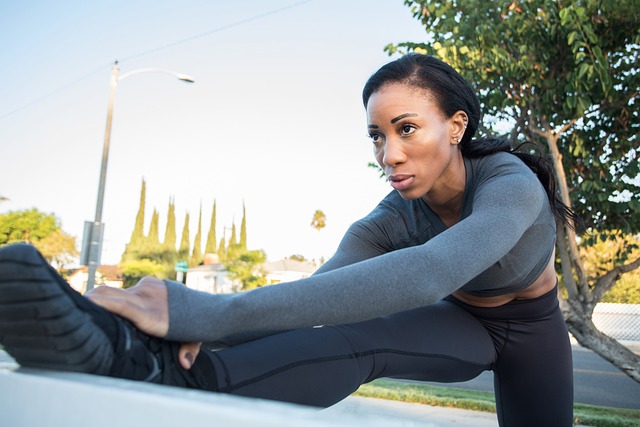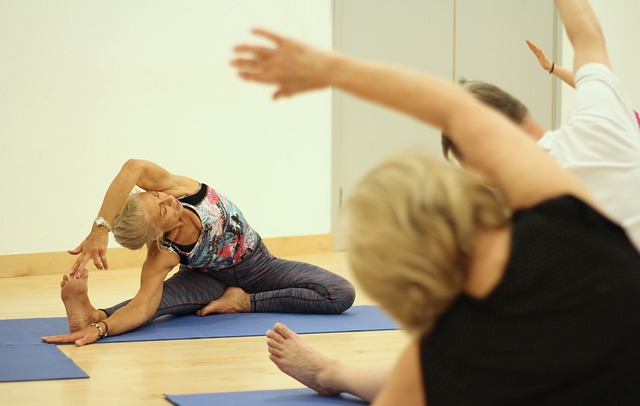Stretching after a run is great for boosting flexibility and mobility.
While stretching after a run can assist any body region, the exercises below focus on areas that typically become tight during and after running. Incorporating these stretches into your post-run routine improves your range of motion, lowers your chance of injury, and improves performance and recovery.
Stretching After a Run
- Stretching the hamstrings
- Quad stretch
- Stretching the calves
- Stretch your low lunges.
- IT band elongation
- Stretching butterfly
- Stretch your hips and back.
- Arm and abdominal stretches
- Triceps elongation
Stretching the Hamstrings
This hamstring stretch is more comfortable on your back than the bending-over stretch. Here’s what you should do:
1. Lie down on your back, legs stretched and back straight. Ascertain that your lower back is flat on the floor and your hips are level.
2. Bend your left knee while keeping your left leg straight on the floor.
3. Straighten your right knee slowly while using both hands to grip the back of your leg.
4. Pull your right leg gently towards you while keeping your hips on the floor. Hold for 20 to 30 seconds. Do the same on the opposite side.
If straightening your leg is too tough, try this stretch with your knee bent.
Quad Stretch

Your quadriceps (front thighs) are strong muscles that work hard when you run; therefore, stretching them is essential. Here’s what you should do:
1. Stand up straight (don’t slouch forward), elevate your cramping leg’s foot behind you, and grip your foot with your hand on the same side.
2. Gently pull your heel toward your buttocks, feeling a stretch in your quad.
3. Maintain your other leg straight and your knees as near together as possible.
4. Maintain the stretch for 15–30 seconds. Releasing and repeating. Switch the legs and repeat the steps on the opposite leg.
Stretching the calves
When you run, your calf muscles work hard, so give them a thorough stretch when you’re done. Stretching your calves can also aid in the prevention of shin splints. Here’s what you should do:
1. To begin, face a flight of steps or an exercise step up.
2. Align your feet so that your toes and ball of your foot the ball of your foot are on the step’s edge. You can add extra support by holding a railing or a wall.
3. Lower one foot’s heel to the ground while bending the opposing leg’s knee. Dropping the heel should cause a stretch in the calf of the leg.

5. Hold this position for 30 to 60 seconds, then switch sides and repeat.
Stretching the Low Lunge
This is a terrific stretch for your hip flexor muscles, which work hard during running to push your legs high. Here’s what you should do:
1. Take a step forward into a lunge position.
2. Maintain a straight upper torso and toes pointed forward. Your back leg should be directly behind you.
3. Use your hands to press down and extend your hips forward until you feel a stretch of your back leg from the front of your pelvis to the top of your thigh.
4. Hold for 30 to 60 seconds before switching sides.
IT Band Elongation
The iliotibial band (ITB), a tendinous and fascial band area that runs from the hip to the knee, is a major source of tension for many runners.
This standing IT band stretch can help lower your chances of developing IT band syndrome.
Here’s how to go about it:
1. Cross your right leg behind your left while standing erect.
2. Lean forward to the left until the outside of your right leg feels stretched.
3. Raise your right hand above your head and extend it to the left side of your body.
4. Hold for 30 seconds, then switch to your left leg.
Stretching Butterfly
The butterfly stretch is also known as the groin stretch. This stretches the inner thighs and groin area.
1. Take a seat and bend your knees until the bottom of your feet together, pointing your knees out to the sides.
2. Wrap your hands over your feet and carefully slide your heels as close to your body as you can comfortably.
3. Slowly lean forward and press your knees into the ground. You should feel your inner thighs being stretched.
4. Lean your chest forward if the stretch feels too easy until your nose touches the ground. However, be cautious not to overdo it.
5. Hold this position for 30-60 seconds. Make sure you don’t bounce when stretching.
6. Return to the starting position slowly and repeat the steps one more time.
Stretch your hips and back.
This stretch is excellent for the hips and lower back. Here’s what you should do:
1. Sit with both legs straight out in front of you.
2. Keep your left leg straight and cross your right leg over your left leg.

3. Bring your right leg to your chest and twist your trunk to look over your right shoulder.
4. Maintain for 15 to 30 seconds.
5. Switch legs and repeat the process.
Arm and Abdominal stretches
This exercise is ideal for stretching your arms and obliques (side abdominals). Here’s what you should do:
1. Place your feet hip-width apart.
2. Raise your arms above your head and drop your shoulders away from your ears.
3. Grab your opposite wrist and bend back as far as your spine allows.
4. Straighten up again and stretch your sides by leaning to the left and then to the right.
Triceps Elongation
Running requires the use of your upper body; therefore, stretching your arms afterward is essential. Stretch your triceps, the muscles on the rear of your upper arm, as follows:
1. Cross one of your elbows across your body to the opposing shoulder.
2. Bring your elbow closer to your shoulder with your other hand.
3. Hold for 15 to 30 seconds before switching sides.
To Conclude
You may be tempted to rest right away after a workout, but don’t be too fast to plop back down and start scrolling through your phone! Stretching for even a few minutes after exercise is essential.
There are various unique advantages to stretching after your workout, including:
Reduces pain and the likelihood of damage. Muscles that remain tight after an exercise are more likely to be injured. Muscle relaxation will lower your risk of injury.
Relaxation through time. Slowing down gradually benefits both the body and the psyche. When you stretch after a workout, you allow yourself to wind down gradually.
Lactic acid elimination. When you exercise, you produce lactic acid. This chemical can cause muscle aches and fatigue. Stretching can help lessen the quantity of lactic acid in your system.
So don’t forget to stretch those muscles for a few minutes.
